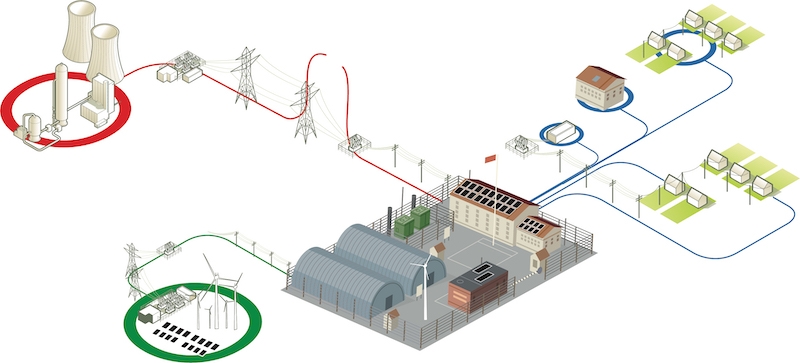
Features
Articles
Grid improvements needed to prevent transformer failures and power outages
April 11, 2019 | By Chris Evanich
 Image courtesy S&C Electric
Image courtesy S&C ElectricApril 11, 2019 – On Dec. 27, 2018, a fiery blue glow lit up the Queen’s neighbourhood in New York, N.Y. It caused quite a stir with people speculating on the cause—with some suggesting the city was under attack by an alien invasion—before the local utility, Consolidated Edison (Con Ed), was able to confirm a transformer was responsible.
The event was quite serious, resulting in significant power outages at LaGuardia Airport and the Rikers Island Prison complex, both of which have heightened security protocols that require constant, reliable power delivery. As flights were delayed and nearby residents panicked, many wondered (a) why a transformer would fail and (b) what could have been done to prevent the power outage.
(For a sense of the magnitude of this issue in the broader sense, consider that the annual cost of short power interruptions (i.e. five minutes or less) is US$60 billion—and in Canada, momentary outages (one minute or less) cost $8 billion annually, while sustained outages cost $4 billion.)
Why transformers fail
Before reviewing why a transformer could have failed, it is important to be familiar with the International Council on Large Electric Systems’ (CIGRE’s) Transformer Reliability Survey, which was published in 2015. Its analysis provided a comprehensive look at power transformer failures, noting that the number one failure mode—based on nearly 1,000 incidents—was due to issues with dielectric, i.e. the insulation within electrical devices.
A breakdown of dielectric will result in a catastrophic transformer failure. The three primary causes of such breakdowns are (a) heat, (b) age and (c) repeated surges. While the first two causes are relatively easy to understand, the third cause requires some explanation.
The New York event on Dec. 27 did not occur during a storm or on a day with record high heat. It is safe to assume the outage was caused by repeated surges to the system.
Transformers and other substation equipment are protected by devices called reclosers. Whenever there is a fault on the distribution feeder, the recloser activates to help minimize the number of customers that will be left out of power.
Reclosing increases fault energy, however, because the process requires closing into the same fault multiple times. This causes additional mechanical and electrical stress on the most expensive assets of the grid, including cabling, conductors, devices that splice and connect the grid together and, as mentioned, transformers. This is why repeated surges are a serious problem.
Recently, alternatives to conventional reclosing technology have reached the market. In fact, they represent the first improvements upon traditional reclosing in more than 70 years.
Unlike reclosing, these alternative methods—such as fault interrupters that only use a small amount of electrical current—do not put damaging fault energy back into the grid. Instead, the technology is energy-limiting.
In fact, it uses 95% less energy than reclosing. As a result, there is stress on the system. Less stress means fewer equipment failures.
To understand the differences between conventional reclosing and fault interrupters, consider this scenario in the kitchen: a pot is warming on your stove and you want to check if it is hot yet. If you grabbed the pot with both of your hands to check its temperature, you could get significantly burned by the heat. If you chose instead to only quickly touch the pot with the back of your hand, you could still gauge how hot it was without hurting yourself.
Similarly, reclosing puts the full force of the fault onto the system, whereas fault interrupters protect the system from significant damage. As such, when it comes to protecting the most expensive assets of the grid, utilities should consider alternatives to reclosing technology, which can be the best option in many cases. Then, their transformers will be less likely to fail catastrophically.
How to prevent power outages
As mentioned, the second question following New York’s incident was what could have been done to prevent the outage. One answer is the increased deployment of microgrids.
Microgrids are complex systems that can combine distributed generation, alternative power sources and distributed loads. When a microgrid is deployed on a feeder, the system will automatically isolate itself from the main grid whenever there is an outage. This is achieved using (a) distributed automation equipment and (b) a microgrid control system.
So, while microgrids are increasingly popular for bringing alternative generation sources online, such as solar, wind and energy storage, they can also be of benefit to the public by preventing utility-scale outages. One such example was deployed by utility Ameren Illinois in 2017, interconnecting natural gas generators, battery-based storage, solar panels and wind turbines into a large-scale microgrid. As for Canadian examples, BC Hydro deployed a battery energy storage project in 2013 to provide a utility-scale microgrid for Field, B.C., while North Bay Hydro Services has more recently developed its Community Energy Park microgrid.
New York’s overall electricity distribution system could accommodate several microgrids working together to help mitigate outages like the one in December. Similar scenarios have played out in Lancaster, Texas, where Oncor linked together four microgrids that can operate independently or as a team., and in Chicago, Ill., where Commonwealth Edison (ComEd) is developing a cluster of microgrids.
Preparing today for tomorrow
When the electrical grid is addressed with improved protection strategies and additional support through microgrids, the effects of outages can be minimized. And as the overall grid continues to grow, it will become all the more important to prevent the exposure of distribution systems to unnecessary stress.
We already have the right technology to avoid catastrophic, costly events. Now it is time to deploy it through grid improvements to avoid major outages in the future.
Chris Evanich is manager of microgrid business development for S&C Electric. For more information, visit www.sandc.com.
This article originally appeared in the April 2019 issue of Electrical Business magazine.
Print this page